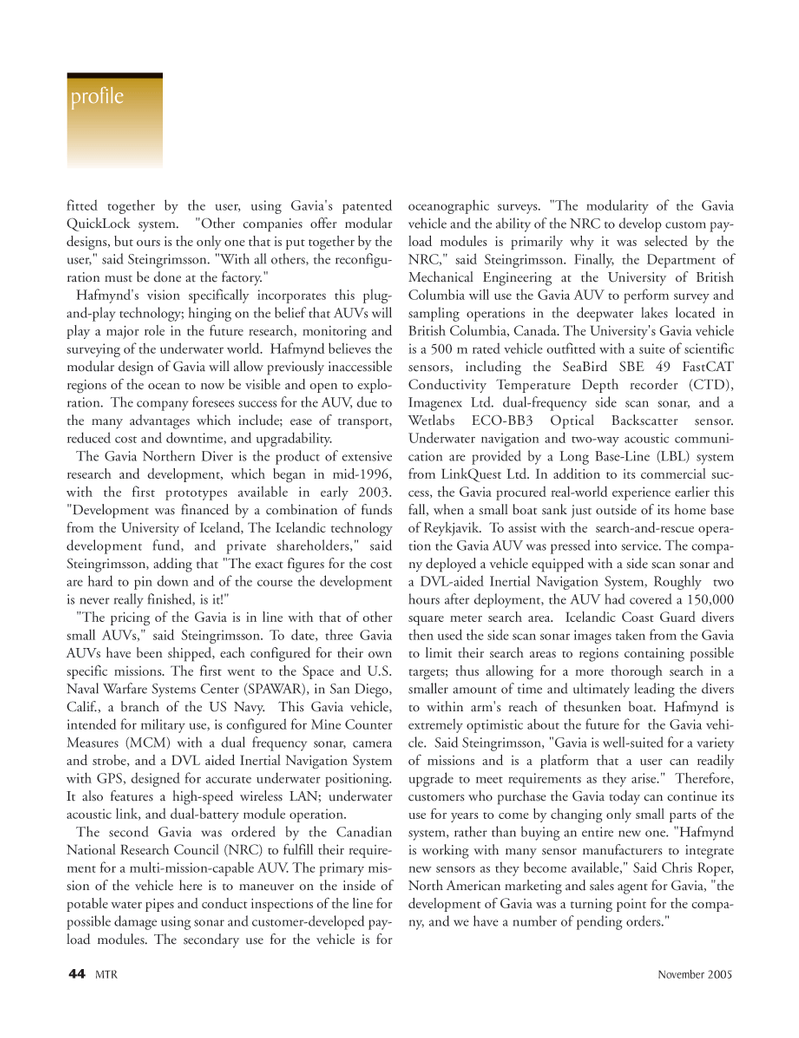
Page 44: of Marine Technology Magazine (November 2005)
Seafloor Engineering
Read this page in Pdf, Flash or Html5 edition of November 2005 Marine Technology Magazine
44 MTR November 2005 profile fitted together by the user, using Gavia's patented
QuickLock system. "Other companies offer modular designs, but ours is the only one that is put together by the user," said Steingrimsson. "With all others, the reconfigu- ration must be done at the factory."
Hafmynd's vision specifically incorporates this plug- and-play technology; hinging on the belief that AUVs will play a major role in the future research, monitoring and surveying of the underwater world. Hafmynd believes the modular design of Gavia will allow previously inaccessible regions of the ocean to now be visible and open to explo- ration. The company foresees success for the AUV, due to the many advantages which include; ease of transport, reduced cost and downtime, and upgradability.
The Gavia Northern Diver is the product of extensive research and development, which began in mid-1996, with the first prototypes available in early 2003. "Development was financed by a combination of funds from the University of Iceland, The Icelandic technology development fund, and private shareholders," said
Steingrimsson, adding that "The exact figures for the cost are hard to pin down and of the course the development is never really finished, is it!" "The pricing of the Gavia is in line with that of other small AUVs," said Steingrimsson. To date, three Gavia
AUVs have been shipped, each configured for their own specific missions. The first went to the Space and U.S.
Naval Warfare Systems Center (SPAWAR), in San Diego,
Calif., a branch of the US Navy. This Gavia vehicle, intended for military use, is configured for Mine Counter
Measures (MCM) with a dual frequency sonar, camera and strobe, and a DVL aided Inertial Navigation System with GPS, designed for accurate underwater positioning.
It also features a high-speed wireless LAN; underwater acoustic link, and dual-battery module operation.
The second Gavia was ordered by the Canadian
National Research Council (NRC) to fulfill their require- ment for a multi-mission-capable AUV. The primary mis- sion of the vehicle here is to maneuver on the inside of potable water pipes and conduct inspections of the line for possible damage using sonar and customer-developed pay- load modules. The secondary use for the vehicle is for oceanographic surveys. "The modularity of the Gavia vehicle and the ability of the NRC to develop custom pay- load modules is primarily why it was selected by the
NRC," said Steingrimsson. Finally, the Department of
Mechanical Engineering at the University of British
Columbia will use the Gavia AUV to perform survey and sampling operations in the deepwater lakes located in
British Columbia, Canada. The University's Gavia vehicle is a 500 m rated vehicle outfitted with a suite of scientific sensors, including the SeaBird SBE 49 FastCAT
Conductivity Temperature Depth recorder (CTD),
Imagenex Ltd. dual-frequency side scan sonar, and a
Wetlabs ECO-BB3 Optical Backscatter sensor.
Underwater navigation and two-way acoustic communi- cation are provided by a Long Base-Line (LBL) system from LinkQuest Ltd. In addition to its commercial suc- cess, the Gavia procured real-world experience earlier this fall, when a small boat sank just outside of its home base of Reykjavik. To assist with the search-and-rescue opera- tion the Gavia AUV was pressed into service. The compa- ny deployed a vehicle equipped with a side scan sonar and a DVL-aided Inertial Navigation System, Roughly two hours after deployment, the AUV had covered a 150,000 square meter search area. Icelandic Coast Guard divers then used the side scan sonar images taken from the Gavia to limit their search areas to regions containing possible targets; thus allowing for a more thorough search in a smaller amount of time and ultimately leading the divers to within arm's reach of thesunken boat. Hafmynd is extremely optimistic about the future for the Gavia vehi- cle. Said Steingrimsson, "Gavia is well-suited for a variety of missions and is a platform that a user can readily upgrade to meet requirements as they arise." Therefore, customers who purchase the Gavia today can continue its use for years to come by changing only small parts of the system, rather than buying an entire new one. "Hafmynd is working with many sensor manufacturers to integrate new sensors as they become available," Said Chris Roper,
North American marketing and sales agent for Gavia, "the development of Gavia was a turning point for the compa- ny, and we have a number of pending orders."
MTR#3 (33-48).qxd 11/14/2005 1:31 PM Page 44

 43
43

 45
45
